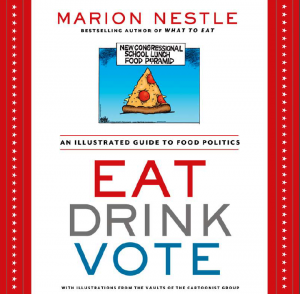Join Health Affairs for a virtual conversation between me and Angela Odoms-Young of Cornell University discussing the evolution of US food and nutrition policy, the current policy landscape, and thoughts on what lies ahead. It’s at 1:00 p.m. EDT. To join the Webinar, click here.
Out today! Eat, Drink, Vote: An Illustrated Guide to Food Politics

Three items:
1. The Cartoonist Group is sponsoring a caption contest. The winner gets a signed copy of the book.
2. If you live in New York: copies will be available at the Union Square farmers’ market tomorrow (Wednesday) from noon to 1:30 p.m.
3. If you’d like a preview, here’s what Nanci Hellmich says about it in today’s USA Today ( This online version comes with a generous helping of interactive cartoons):
Cartoons poke fun at weight, diet and food politics
A new book, “Eat, Drink, Vote,” has more than 250 cartoons that take a humorous look at food topics.
STORY HIGHLIGHTS
- Nutrition professor Marion Nestle says cartoons can spotlight food politics
- She shares more than 250 of her favorite cartoons in her new book
- Her goal: Have people get active in food politics
When it comes to diet, weight and food politics in this country, cartoons often make the messages easier to swallow.
Cartoons and comics can convey “complicated conceptual information at a glance, and if they are good, make it funny, pointed, sharp, ironic and sometimes even sarcastic,” says Marion Nestle, a longtime nutrition professor at New York University and veteran consumer advocate. “In one drawing, cartoonists can convey not only what the idea is about, but what they think about it.”
Nestle shares more than 250 of her favorite cartoons and comics in her new book, Eat, Drink, Vote: An Illustrated Guide to Food Politics, (Rodale Books, $18.99) created in collaboration with The Cartoonist Group.
For years, Nestle has hounded the food industry about its marketing strategies, which she detailed in her 2002 book, Food Politics. In 2006, she detailed how to grocery shop for a healthful diet in What to Eat, and in 2012 she discussed the latest science on what causes people to be overweight in Why Calories Count, written with Malden Nesheim.
Nestle believes that the obesity problem is this country is fostered by a food environment that encourages people to eat more often, in more places and in larger amounts than is good for maintaining a healthy weight.
About a third of adults in this country are obese, which is roughly 35 or more pounds over a healthy weight. A third of children and teens are overweight or obese. Obesity increases the risk of many diseases including type 2 diabetes, heart disease and some types of cancer.
Beginning in the 1980s when obesity rates in this country started to climb, food became more widely available with the proliferation of fast-food places and the increase in portion sizes, she says. People started eating outside of the home more often and snacking more frequently, Nestle says.
She says the current food environment results from the need of food companies not only to make a profit but to report an increase in profits to Wall Street every 90 days — and do so in a highly over-abundant and fiercely competitive marketplace. To lose weight, she says, people have to eat less, but eating less is terrible for business. Hence: politics.
Nestle says there are many examples of what she considers food politics run amok. One case in point: The U.S. Department of Agriculture established new nutrition standards for school lunches that went into effect in the 2012-2013 school year. But bowing to pressure from food companies, “Congress insisted that the USDA count the tomato paste on pizza as a serving of vegetables,” Nestle says.
“It’s ridiculous to have Congress micromanaging school food rules. Several cartoons in the book make that point brilliantly.”
About the book, Nestle says: “I want these cartoons to inspire readers to become active in food politics, personally and politically. You can buy food at farmers markets, go to grocery stores that sell healthier foods, support locally grown food and organic food, support animal welfare.
“There are loads of ways to choose foods and diets that will be healthier for people and the planet. Everyone who’s interested can join groups that are working for policies that will make healthy food choices the easy choices.”
Vote with your fork, she says. “Even better, vote with your vote!”
And #4: a couple of other items related to the book:
August 31 Review in the San Francisco Chronicle
August 14 Interview with Kerry Trueman on Amazon.com

